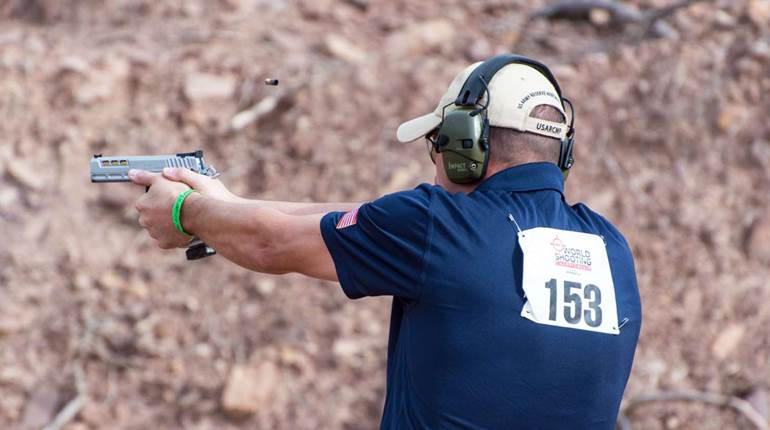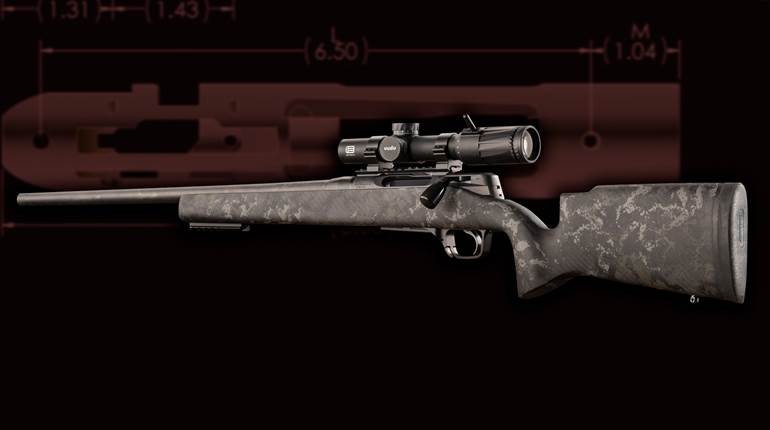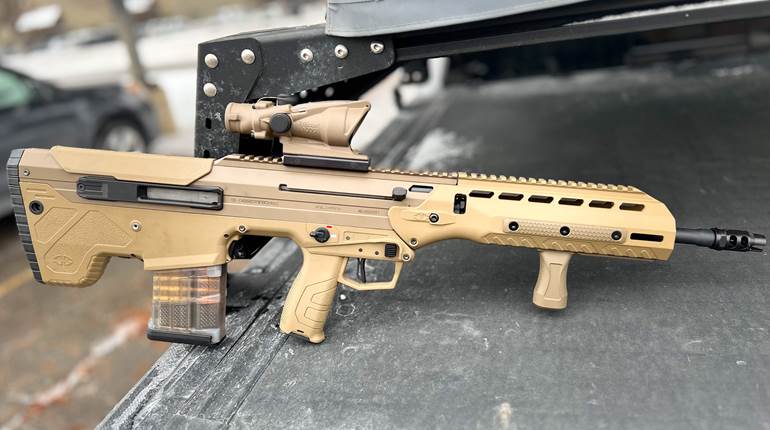
7/19/2012
So, hypothetically, when do you think I might actually see my bag again?” The question posed to the very helpful Air Botswana agent in the Kasane airport was of a more urgent nature than that of a typical traveler merely seeking a clean change of underwear. Not that I couldn’t use them, too, of course, but I could—and did—borrow skivvies. You see that bag contained my ammunition, which I had packed in Virginia seven days previous, and ammunition is kind of important on a safari.
In that bag—amongst all my other gear—were 60 gleaming, nickel-plated, belted, sausage-like rounds of Federal Premium Safari .458 Lott loaded with 500-grain Trophy Bonded Sledgehammer bullets. Six days into a 10-day safari with a change of venue from the Caprivi in eastern Namibia to the mountains near Windhoek slated for two days later made the matter somewhat urgent to me. Of our group, which included Federal Premium’s Tim Brandt, Kimber’s Dwight Van Brunt and outdoor writer Mike Scobey, I had the only .458. Van Brunt and Scobey, hunting hippo and crocodile, had .375 H&H Magnums. Brandt’s rifle, destined to take a Cape buffalo—and eventually my elephant—was in .416 Rem. Mag.
I had spent day after day practicing with the Lott, ramping up for the opportunity to take an “own use” elephant in the Kasika Conservancy, with all the meat going to feed the Kasika people and the tusks, if there were any, going to the conservancy as well. In the Caprivi Strip, the Chobe River separates the nations of Botswana and Namibia. On the Botswana side, the area includes the Chobe Game Park and one of Africa’s most travelled tourist destinations. On the Namibian side, it is far more undeveloped, and there are far too many elephant in the area—on both sides of the river. As a matter of fact, the animal I hunted for six days and ended up taking was declared a “problem” by Namibia Game and Parks due to a bachelor herd’s refusal to leave a village. Contrary to popular opinion, elephant in that part of Africa are nowhere near endangered and, in many areas, are dangerously overpopulated.
The Beast
It was the power of the .458 Lott cartridge that drew me to choose it, as it is a considerable step up in power from the .458 Win. Mag. Based on the .375 H&H Mag. case and introduced in 1956, the .458 Win. Mag. has a belted case tapering from 0.513 inches ahead of the belt to 0.483 inches at the case mouth. Factory tables, likely exaggerated at the time, originally quoted the cartridge as moving a 0.458-inch, 510-grain bullet at about 2,130 fps through a 24-inch-barreled rifle.
A gunsmith, big-game hunter and one-time technical editor of Guns & Ammo, Jacque P. Lott hunted Africa often, and he was almost killed in 1959 when a .458 Win. Mag. failed to penetrate to his satisfaction on a Cape buffalo. That set Lott in search of .45-cal. cartridge with more power and penetration than was offered at the time in .458 Win. Mag. Lott was looking for a .500-grain, 0.458-inch bullet in the 2,200- to 2,300-fps range from a 22-inch barrel. With no factory cartridge available, he decided to make his own.
The .458 Lott, too, is based on the .375 H&H Mag., but the maximum cartridge overall length is 3.600 inches—0.260-inches longer than the 3.340 inches of the .458 Win. Mag. One of the virtues of the Lott is that .458 Win. Mag. ammunition can be fired out of a .458 Lott-chambered rifle, which may be helpful in remote parts of the world. I say “may” because it helped me not at all.
According to its factory data, Federal Premium Safari Ammunition’s 500-grain Trophy Bonded Sledgehammer .458 Lott loading delivers 2,300 fps.at the muzzle and 5,875-ft.lbs. of energy. The same bullet in the company’s .458 Win. Mag. factory load leaves the muzzle at 1,950 fps. delivering 4,221 ft.-lbs. of energy. Over an Oehler Model 35P, out of the 24-inch-barreled Caprivi at 15 feet, the Lott load ran at 2,283 fps—very close to the factory number—with 5,786 ft.-lbs. of energy. That is more than 1,500 additional ft.-lbs. of energy over the .458 Win. Mag.
The Federal loading I chose uses the Trophy Bonded Sledgehammer, which has a thick bronze jacket bonded around its lead core. It has a flat meplat (marked with a “T”) and is designed for straight-line, deep penetration. The 500-grain bullet in the Lott has three relief grooves around its shank to improve accuracy and reduce pressure, which, judging from my range sessions, seems to have indeed helped with the former.
Between zeroing, testing for accuracy and practicing before the trip, I fired more than 80 rounds of .458 Lott and another 60 of .458 Win. Mag. I knew the rifle well. Off a Caldwell Lead Sled DFT II (which I broke a weld on at round 24) it delivered a 1.17-inch group at 100 yards. Off sticks at 50 yards, I could keep three shots within 4 inches while working the bolt with alacrity.
I have had relatively few genuinely unpleasant experiences with firearms. The majority of them involve the .458 Lott cartridge. A friend who worked with Lott once said of the cartridge: “It’s unpleasant; just like the man who made it.” It is not really the cartridge’s fault; it is merely doing its job, delivering a powerful blow sufficient to fell the largest beasts that walk the earth. The Lott’s most recent transgression? The sin of omission. For the latter, blame cannot actually be assigned to the cartridge; that belongs to the crack baggage-handling team in Atlanta.
I have shot five rifles chambered for .458 Lott—owned two and broken two (neither Kimbers)—and must say that the Caprivi is the one that handles the recoil best, points most naturally, shoulders quickly and is utterly reliable. The name is derived from the narrow strip of land in Northeastern Namibia that linked what was German South West Africa to the Zambezi River and Germany’s former colony on the East African coast, Tanganyika. And I was fortunate enough to take one there to the wild land that gave the rifle its name.
The Caprivi does not have a true magnum length action—one that would accept say a .416 Rigby—but it is built on the 8400’s 1.365-inch-diameter, cylindrical receiver and accepts certain magnum cartridges. The ejection port is 3.51-inches long, so complete .458 cartridges must be just slightly angled for insertion into the magazine. The heart of the Caprivi is its dual-opposed locking lug bolt, which borrows from both the Model 98 and the Arisaka. The claw extractor is on the bolt’s right, and there is a three-position wing safety on the bolt shroud’s right.
The 24-inch-long barrel has a magnum contour with the front sling swivel mounted ahead of the fore-end on a steel barrel band. Kimber describes the chamber as “match grade,” and indeed the rifle was more accurate than it will need to be in the field. There are aluminum pillars for the two stock screws, the barrel is free-floated, and the receiver is bedded its entire length.
The stock has excellent lines and ergonomics, a blend of vintage English Mauser 98-based rifles and classic American lines. On the stock’s left is a pancake-style cheekpiece, and its pistol grip has an open radius, which keeps the knuckles from rapping the trigger guard under recoil. There is a 1-inch-thick Pachmayr XL Decelerator recoil pad with plenty of surface area to spread out the Lott’s considerable recoil.
I selected Weaver’s Dangerous Game 1-5X 24 mm riflescope mounted in Talley rings with throw levers to allow rapid removal of the scope. The Weaver took the pounding every time I pulled the trigger without issue. I will be completely forthright; I did not shoot the square to test the repeatability of the scope. I am not man enough for that. That said, in zeroing, the adjustments worked as advertised, and once set, stayed where they belonged all the way across the world and back.
After Brandt took a fine buffalo with his .416, and with no sign of my ammunition, it was time to make a new plan. I gave up on my bag and its vital contents, borrowed Tim’s rifle, and zeroed it for 400-grain Trophy Bonded Sledgehammers. The next day I took the troublesome elephant bull with that combination.
And then my bag arrived in Kasane.
Manufacturer: Kimber
Model: 8400 Caprivi
Caliber: .375 H&H Mag., .416 Rem. Mag., .458 Lott (tested)
Action Type: bolt-action
Receiver: Matte 4140 steel
Finish: Matte blue
Magazine: internal, four rounds
Overall Length: 44 5/8”
Barrel: 24: Magnum contour
Rifling: button-rifled, six-groove, 1:12” RH twist
Weight: 8 lbs., 11 ozs.
Sights: NECGS white bead front, windage adjustable three leaf express rear
Trigger: adjustable, single-stage; 3-lb., 8-oz. pull
Stock: AA-grade, oil-finish French walnut: Length of pull 13 3/4"; drop at heel 1/2"; drop at comb 5/8”
Suggested Retail Price: $3,263
The Beauty
As our time in the Caprivi was extended, and we had only two short days to hunt in the mountains of central Namibia at Panorama Camp, the unfenced preserve that is home to Jamy Traut’s main plains game hunting operation, it was not until day nine of 10 that I finally uncased the beauty for time afield. A Model 84L Kimber Classic Select chambered in .30-’06 Sprg., the rifle’s stock was simply beautiful. The catalog says hand-rubbed French A-grade walnut, but (not to get anyone at the factory in trouble) this gun’s bold, straight grain looks a little closer to AA to me. Setting off the grain is well-executed 20 line-per-inch bordered-point-pattern checkering adorning the wrist and fore-end, blemished only by a few flattened points. And there is an ebony fore-end tip, too. The comb is straight, and the semi-pistol grip has an open radius that is tipped by a blue grip cap.
There are three action sizes in Kimber bolt rifles, the .308 Win.-size short-action, the long action Model 8400 Magnum that accepts up to .338 Win. Mag. and the medium-size Model 84L designed specifically around the .30-’06 Sprg. cartridge. No dimension is greater than it absolutely needs to be. What this minimalist approach means is that the rifle weighs only 6 pounds, 3 ounces with its 24-inch sporter-contour barrel, sans scope, rings or bases. Like other Kimbers, the bolt is two-lug design with an external claw extractor on the right, and the internal magazine holds five rounds. The matte-blue steel metal work does not bear the polish of a Super America, nor does the price reflect that level of handwork.
The 84L is capable of quite good accuracy. With the 180-grain Trophy Bonded Tipped factory load I chose, I had several groups under the sub-minute-of-angle mark, although barrel heat becomes as issue with extended shooting sessions. If you want the groups to stay small, you need to let the barrel cool. For optics, I mounted a Weaver Super Slam 2-10X 40 mm riflescope. Before leaving Virginia, I did shoot the square with it, and found it to be repeatable (within 1/16 inches center to center at 100 yards) and the pull-up-to-turn adjustments extremely useful.
Finally I had my chance with the .30-’06 Sprg. On the first afternoon at Panorama Camp, I took a rest on Jamy’s Traut’s shooting sticks, took a deep breath and began the squeeze. The rifle barked, and 165 yards away the Trophy Bonded Tipped passed completely through a fine Springbok ram, flipping it over once and depositing the creature on the ground.
On the last night of the hunt, bags already packed for the long return trip home, as we sat around the final campfire of an incomparable safari, I turned to Van Brunt in the half light of the fire’s dying embers and said, “You know, I’m kind of glad the Lott didn’t arrive in time.”
Manufacturer: Kimber
Model: 84L Classic Select
Caliber: .25-’06 Rem., .270 Win., .30-’06 Sprg.
Action Type: bolt-action center-fire
Receiver: Matte 4140 steel
Finish: Matte blue
Magazine: internal, five rounds
Overall Length: 43 1/8”
Barrel: 24” light sporter contour
Rifling: button-rifled, six-groove, 1:10” RH twist
Weight: 6 lbs., 3 ozs.
Sights: None, drilled and tapped for Kimber scope bases
Trigger: adjustable, single-stage; 3-lb., 2-oz. pull
Stock: A-grade French walnut
Suggested Retail Price: $1,359






































